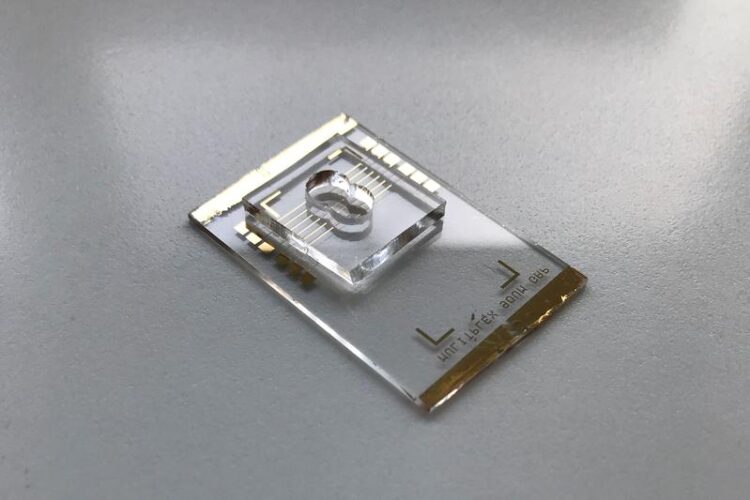Nanobiosensor Developed for Detecting SARS-CoV-2

Image of the complete sensor including a PDMS well of 100 μL volume for drop testing. The liquid sample of interest is dispensed in the well and allowed to incubate.
Source: HZDR/Sandoval Bojorquez
Infection and immunity status of the population are considered key parameters for handling pandemics. For this purpose, detecting antigens and antibodies is of great importance. The devices currently used for this purpose – what are known as point-of-care (POC) devices- are one option for rapid screening. Their sensitivity, however, needs further improvement.
Scientists at the Helmholtz-Zentrum Dresden-Rossendorf (HZDR) have been successful in such improvement by developing a nanobiosensor based on gold nanowires. Originally only intended for the detection of COVID-19-associated antigens and antibodies, the biosensor is also transferable to other biomarkers.
It is by now known from numerous studies that for detecting SARS-CoV-2, what are referred to as POC lateral flow tests (LFT) are a good and precise alternative to the reverse transcriptase-polymerase chain reaction, commonly known as PCR tests. The numerous advantages of LFT over PCR testing include rapid detection, on-site testing, low cost, and operation without laboratory equipment.
The greatest shortcoming of POC biosensors, however, is that their sensitivity is dependent on viral load. At a high viral load, sensitivity is one hundred percent, whereas at a low viral load, sensitivity may fall below ten percent. This can lead to false negative test results. The HZDR researchers’ aim was to develop sensor systems that can also be used for detecting low virus loads while providing quick and accurate results.
To do so, Dr. Larysa Baraban and her team at the HZDR-Institute of Radiopharmaceutical Cancer Research utilized nano wires made of gold, which can be employed to detect various biomolecules such as enzymes, proteins and antibodies. This approach was combined with electrochemical impedance spectroscopy, a technique that provides information on various processes at the electrode-electrolyte interface, including charge transfer, diffusion transport and formation of an electrical double layer, as well as on the properties of the measurement system. This includes solution resistance and roughness or porosity of the electrode surface.
“In our work, we have developed a nanoscopic biosensor chip consisting of six pairs of interlocking gold nanowire devices for detecting SARS-CoV-2 antigens and antibodies,” says Baraban of the project. “This makes it possible to detect both COVID-19-associated antigens and corresponding antibodies that appear during and after infection with the virus. We assume that the method is also transferable to other biomarkers and pathogens. The functional layer targeting the biomolecule must be modified accordingly for this purpose.”
Considerations and discussions are currently underway with the industry on how the sensor can be manufactured in large quantities at low cost.
This measure is co-financed from tax revenue based on the budget passed by the Saxonian Parliament.
Wissenschaftliche Ansprechpartner:
Dr. Larysa Baraban I Institute of Radiopharmaceutical Cancer Research
Phone: +49 351 260 3091 I email: l.baraban@hzdr.de
Originalpublikation:
Impedimetric Nanobiosensor for the Detection of SARS-CoV-2 Antigens and Antibodies
Diana Isabel Sandoval Bojórquez,Željko Janićijević, Brenda Palestina Romero, Eduardo Sergio Oliveros Mata, Markus Laube, Anja Feldmann, Alexandra Kegler, Laura Drewitz, Ciarán Fowley, Jens Pietzsch, Juergen Fassbender, Torsten Tonn, Michael Bachmann, and Larysa Baraban
https://pubs.acs.org/doi/10.1021/acssensors.2c01686
Media Contact
All latest news from the category: Medical Engineering
The development of medical equipment, products and technical procedures is characterized by high research and development costs in a variety of fields related to the study of human medicine.
innovations-report provides informative and stimulating reports and articles on topics ranging from imaging processes, cell and tissue techniques, optical techniques, implants, orthopedic aids, clinical and medical office equipment, dialysis systems and x-ray/radiation monitoring devices to endoscopy, ultrasound, surgical techniques, and dental materials.
Newest articles

Largest magnetic anisotropy of a molecule measured at BESSY II
At the Berlin synchrotron radiation source BESSY II, the largest magnetic anisotropy of a single molecule ever measured experimentally has been determined. The larger this anisotropy is, the better a…

Breaking boundaries: Researchers isolate quantum coherence in classical light systems
LSU quantum researchers uncover hidden quantum behaviors within classical light, which could make quantum technologies robust. Understanding the boundary between classical and quantum physics has long been a central question…

MRI-first strategy for prostate cancer detection proves to be safe
Active monitoring is a sufficiently safe option when prostate MRI findings are negative. There are several strategies for the early detection of prostate cancer. The first step is often a…



